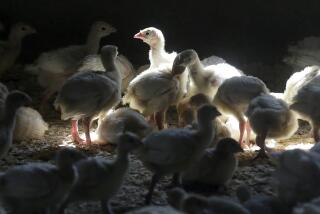Researchers inch closer to a universal flu vaccine
- Share via
Someday, patients may no longer have to get a new flu shot each year, tailored to the particular strains expected to dominate in a given season. That’s because scientists are homing in on new methods of formulating vaccines that will be able confer immunity against multiple varieties of influenza -- a feat they haven’t been able to achieve in the past.
On Monday, two teams reported independently that they had mimicked a tiny portion of the flu virus known as a hemagglutinin stem, helping them develop experimental vaccines that protected animals against several flu types.
“This is an early step,” said Barney Graham, deputy director of the Vaccine Research Center at the National Institute of Allergy and Infectious Diseases in Bethesda, Md. and senior author of one of the research papers outlining the advances. “But it is promising.”
One reason why it’s been hard to formulate a universal flu vaccine that works against all strains of the virus is that influenza is a shape shifter that mutates rapidly and often. Even if a person develops immunity against a particular flu from immunization or from having been sickened by it, he or she won’t necessarily have immunity to a similar flu that has evolved to be slightly different.
A great deal of the human immune response to influenza is directed against a protein on the virus called hemagglutinin -- and in particular, a portion of the protein called the hemagglutinin head, where many mutations occur.
In the 1990s and 2000s, Graham said, scientists learned that some people seemed to develop broadly acting antibodies that neutralized a variety of flus by targeting a different location on the hemagglutinin protein known as the stem, where mutations do not occur as often. But the human immune system doesn’t create antibodies against the stem as readily as it creates them to combat the antigens on the head, in part, researchers think, because of simple geography: The hemagglutinin sits atop the virus with the head exposed and the stem hidden.
The two research groups took different technical approaches to nearly identical concepts, said Andrew Ward, a structural biologist at the Scripps Research Institute in La Jolla who was involved in the other research effort. Hoping to amp up the immune system’s production of stem-specific antibodies that might battle a wider variety of flu viruses, the teams both decided to take the distracting hemagglutinen head out of the picture and create stem-only antigens to incorporate into vaccines.
The task was tricky, because the stem-like molecule would usually be anchored in the membrane of the flu virus and also attached to the hemagglutinin head. One atom out of place can disrupt the intended antibody response, so both teams had to monitor the molecules they were building closely, studying them under high-powered microscopes and tweaking as they worked.
“Flu is a very large virus with lots of parts,” Ward said. “It’s very hard to build a small piece without screwing things up.”
Once they had built stable molecules, they created vaccines and tested them. Ward’s group, which published its study in the journal Science, was able to elicit immune responses and varying levels of protection from illness in mice and monkeys. The members of Graham’s team, whose results appeared in Nature Medicine, found that their vaccine provided protection across flu subtypes in mice and in ferrets.
Graham said that, moving forward, his lab would work on hemagglutinins from more types of flus, and that he also hoped to bring the vaccines into clinical trials in people. Certain genetic differences between people and animals may mean that humans will have a stronger response to the vaccine than the mice, ferrets or monkeys did, Graham said.
A universal flu vaccine won’t be available right away, he added. If it does become a reality one day, he said, it would probably be similar to the tetanus vaccine, which requires a booster shot every 10 years -- rather than like vaccines received only during childhood.
More than just providing a convenience for needle-weary patients, a universal vaccine would also help prevent pandemic outbreaks by offering a head start on protection against a wider swath of strains, Ward said.
Today’s seasonal flu shots can only incorporate three or four strains at a time, he said.
For more on science and health, follow me on Twitter: @LATerynbrown







